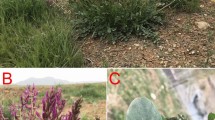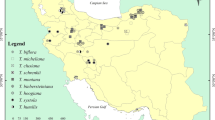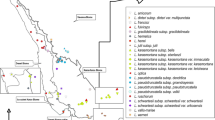Abstract
This study investigated the genetic relationships between the rare terrestrial orchid Diuris fragrantissima and three closely related purple flowered species using Amplified Fragment Length Polymorphisms. The purple-flowered species were found to form individual phenetic clusters confirming recognition of D. fragrantissima at the rank of species. Levels of genetic variation were lower within D. fragrantissima than within its closest relatives but were higher than expected for severely bottlenecked species. Gene flow was detected among all species (Nm = 2.34) and populations (Nm = 0.65) however low among population gene flow indicates that populations may be at risk of divergence. This study has implications for the conservation of D. fragrantissima.
Similar content being viewed by others
References
Arft, A.M. and Ranker, T.A.: 1998, ‘Allopolyploid Origin and Population Genetics of the Rare Orchid Spiranthes diluvialis,’ Am. J. Bot. 85(1), 110–122.
Clements, M.L.: 1989, ‘Catalogue of Australian Orchidaceae,’ Aust. Orchid Res. 1, 1–160.
Cozzolino, S., Noce, M.E., Musacchio, A., and Widmer, A.: 2003, ‘Variation at a Chloroplast Minisatellite Locus Reveals the Signature of Habitat Fragmentation and Genetic Bottlenecks in the Rare Orchid Anacamptis palustris (Orchidaceae),’ Am. J. Bot. 90(12), 1681–1687.
Despres, L., Pettex, E., Plaisance, V., and Pompanon, F.: 2002, ‘Speciation in the Globeflower Flies Chiastocheta spp. (Diptera: Anthomyiidae) in Relation to Host Plant Species, Biogeography and Morphology,’ Mol. Phylogenet. Evol. 22, 258–268.
Despres, L., Gielly, L., Redoutet, B., and Taberlet, P.: 2003, ‘Using AFLP to Resolve Phylogenetic Relationships in a Morphologically Diversified Plant Species Complex When Nuclear and Chloroplast Seqeuences Fail to Reveal Variability,’ Mol. Phylogenet. and Evol. 27, 185–196.
Ellstrand, N.C. and Elam, D.R.: 1993, ‘Population Genetic Consequences of Small Population Size: Implications for Plant Conservation,’ Annu. Rev. Ecol. Syst. 24, 217–242.
Forrest, A.D., Hollingsworth, M.L., Hollingsworth, P.M., Sydes, C., and Bateman, R.M.: 2004, ‘Population Genetic Structure in European Populations of Spiranthes romanzoffiana Set in the Context of Other Genetic Studies on Orchids,’ Heredity 92(3), 218–227.
Guo, Y., Saukel, J., Mittermayr, R., and Ehrendorfer, F.: 2005, ‘AFLP Analyses Demonstrate Genetic Divergence, Hybridization, and Multiple Polyploidization in the Evolution of Achillea (Asteraceae-Anthemideae),’ New Phyt. 166(1), 273–289.
Hamrick, J.L. and Godt, M.J.W.: 1989, ‘Allozyme Diversity in Plant Species,’ in A.H.D. Brown, M.T. Clegg, A.L. Kahler, and B.S. Weir (eds.), Plant Population Genetics, Breeding, and Genetic Resources, Sinauer, Sunderland, Massachusetts, USA, pp. 43–63.
Hamrick, J.L., Godt, M.J.W., Murawske, D.A., and Loveless, M.D.: 1991, ‘Correlations Between Species Traits and Allozyme Diversity: Implications for Conservation Biology,’ in D.A. Falk and K.E. Holsinger (eds.), Genetics and Conservation of Rare Plants, Oxford University Press, New York, USA, pp. 195–208.
Hedren, M., Fay, M.F., and Chase, M.W.: 2001, ‘Amplified Fragment Length Polymorphisms (AFLP) Reveal Details of Polyploid Evolution in Dactylorhiza (Orchidaceae),’ Am. J. Bot. 88(10), 1868–1880.
Jones, D.L. and Jones, B.: 2000, A Field Guide to the Native Orchids of Southern Australia, Blooming Books, Hawthorn, Victoria.
Jones, D.L. and Clements, M.A.: 2004, ‘Diuris daltonii (C. Walter),’ Orchadian 14(8: Scientific Suppl.), xiv.
Koopman, W.J., Zevenbergen, M.J., and Van den Berg, R.G.: 2001, ‘Species Relationships in Lactuca s.l. (Lactucaceae, Asteraceae) Inferred from AFLP Fingerprints,’ Am. J. Bot. 88(10), 1881–1887.
Larson, A., Wake, D.B., and Yanev, K.P.: 1984, ‘Measuring Gene Flow Among Populations Having High Levels of Genetic Fragmentation,’ Genetics 106, 293–308.
Nei, M.: 1972, ‘Genetic Distance between Populations,’ Am. Nat. 106, 283–292.
Nybom, H. and Bartish, I.: 2000, ‘Effects of Life History Traits and Sampling Strategies on Genetic Diversity Estimates Obtained with RAPD Markers in Plants,’ Persp. in Plant Ecol., Evol. and Syst. 3/2, 93–114.
Nybom, H.: 2004, ‘Comparison of Different Nuclear DNA Markers for Estimating Intraspecific Genetic Diversity in Plants,’ Mol. Ecol. 13, 1143–1155.
Pridgeon, A.M., Solano, R., and Chase, M.W.: 2001, ‘Phylogenetic Relationships in Pleurothallidinae (Orchidaceae),’ Lindleyana 16, 235–271.
Pryde, E.: 2001, ‘A Molecular Approach to the Conservation of One of Australia’s Rarest Orchids, the Sunshine Diuris, Diuris fragrantissima,’ Honours thesis, RMIT, Melbourne, Australia.
Rohlf, F.J.: 1998, ‘NTSYS-pc Numerical Taxonomy and Multivariate Analysis System, Version 2.0,’ Exeter Publishing, Ltd., Setauket, New York, USA.
Sharma, I.K. and Jones, D.L.: 1996, ‘An Electrophoretic Study of Variability in Diuris sulphurea R. Br. (Orchidaceae) in the Canberra Region,’ J. Orchid. Soc. India 10, 9–24.
Sharma, I.K., Jones, D.L., and French, C.J.: 2003, ‘Unusually High Genetic Variability Revealed Through Allozymic Polymorphism of an Endemic and Endangered Australian Orchid, Pterostylis aff. Picta (Orchidaceae),’ Biochem. Syst. and Ecol. 31, 513–526.
Slatkin, M.: 1987, ‘Gene Flow and the Geographic Structure of Natural Populations,’ Science 236, 787–792.
Smith, Z.F., Murphy, D., James, E.A., and McLean, C.B.: 2005, ‘Chloroplast Sequencing of Four Australian Terrestrial Orchids from the Diuris ‘punctata’ Group,’ Selbyana 26(1–2), 217–228.
Swofford, D.L.: 1998, ‘PAUP*: Phylogenetic Analysis Using Parsimony and Other Methods,’ Version 4.b1. Sinauer, Sunderland, Massachusetts, USA.
Wright, S.: 1931, ‘Evolution in Mendelian Populations,’ Genetics 16, 97–159.
Yeh, F.C., Yang, R.C., Boyle, T.B.J., Ye, Z.H., and Mao, J.X.: 1999, ‘POPGENE 3.2, The User-Friendly Shareware for Population Genetic Analysis,’ Molecular Biology and Biotechnology Centre, University of Alberta, Edmonton.
Author information
Authors and Affiliations
Corresponding author
Rights and permissions
About this article
Cite this article
Smith, Z.F., James, E.A. & McLean, C.B. Investigation of the phylogenetic relationships between Diuris fragrantissima and its closest relatives using AFLPs. Environmentalist 27, 217–226 (2007). https://doi.org/10.1007/s10669-007-9025-8
Published:
Issue Date:
DOI: https://doi.org/10.1007/s10669-007-9025-8




